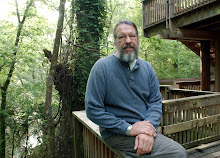Four or five years ago, when Lydia and I still had the native plant nursery, we had a dozen or so bare-root live oak seedlings left over from a job. At that time I knew that Louis and Ashlee Michot were planting trees around their new place between Grand Coteau and Arnaudville, so I called them up to come and get the oak seedlings. We couldn't synchronize our schedules so I told them that I'd leave the seedlings in our potting area and they could just come and pick them up at their convenience.
Eventually they did come to get the oaks; and as an afterthought I guess, Louis heeled in (half-buried) a handful of wildflower seedlings in a pot of bark mulch lying around the potting area. We were really busy with stuff back then, so those seedlings had to fend for themselves, surviving in that pot of bark mulch without any supplemental fertilizer or water. In fact, they had to survive there for over a year before Lydia finally rescued them and planted them in her “herb wheel” on the west side of the yard.
Over the years, I didn't take much note of them. Then, this past spring they forced me to notice them via the sheer beauty of their blooms – and their numbers. Turned out to be prairie larkspurs (Delphinium carolinianum; aka “Carolina Larkspur”). In the intervening three years they had spread nicely, seeding themselves throughout the whole herb wheel.
little miracles
So I recently called Louis to get the story on the larkspurs. He barely remembered the details, but apparently, he had snatched up a handful of them as his band (the fabulous Lost Bayou Ramblers) was journeying home from a gig in Texas. They must have still been in his vehicle when he stopped to pick up the oak seedlings.
Larkspurs belong to the Ranunculus or Crowfoot plant family, a large group comprised of over 1,000 species – most of them very showy bloomers. Other Crowfoot family members include buttercups, Clematis, columbines, meadow-rues, and Anemones. There are over 150 species of larkspurs alone. Here in North America, we probably have 50-75 species and subspecies.




